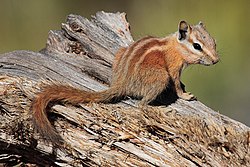This article has multiple issues. Please help improve it or discuss these issues on the talk page . (Learn how and when to remove these messages)
|
| Hopi chipmunk | |
|---|---|
 | |
| Scientific classification | |
| Kingdom: | Animalia |
| Phylum: | Chordata |
| Class: | Mammalia |
| Order: | Rodentia |
| Family: | Sciuridae |
| Genus: | Neotamias |
| Species: | N. rufus |
| Binomial name | |
| Neotamias rufus (Hoffmeister & Ellis, 1979) | |
| Synonyms | |
| |
The Hopi chipmunk (Neotamias rufus) is a small chipmunk found in Colorado, Utah and Arizona in the southwestern United States. It was previously grouped with the Colorado chipmunk (N. quadrivittatus). This species is listed as "Least Concern" on the IUCN Red List as it is common, widespread, and without any major threats. [1] It was last evaluated in 2016.
